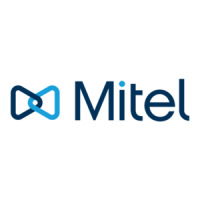About MiVoice Border Gateway
5
The MiVoice Border Gateway (MBG) Blade provides advanced functionality such as Application and
Web Proxy, Teleworker support, Advanced SIP Trunk proxying (including KPML), Secure Recording
Connector (SRC), SIP Trunk Proxying allows connection to an external Call Recording Equipment
(CRE), API and Proxy for remote applications, CloudLink Gateway, and Advanced SIP Trunk proxying
(including Key Press Markup Language (KPML)
3
).
Note:
You must license the solution prior to installing any Blades.
MiVoice Border Gateway functions included:
•
SIP Trunk proxy – for Telco Connectivity
•
Teleworker – for SIP and MiNET devices
•
API and Proxy for remote applications
•
Call Recording –Secure Recording Connector (SRC) function
•
CloudLink Gateway (CLGW)
Limitations
•
The embedded MiVoice Border Gateway can share the licenses with other MiVoice Border
Gateways in the cluster.
•
The MiVoice Border Gateway Blade on SMB Controller can only use the Server Gateway Mode
deployment model using the co-resident with Call Manager Networking Profile.
•
The embedded MiVoice Border Gateway is scaled to support up to 150 users on the SMB
Controller. Increased scaling can be obtained with an external off-board MiVoice Border Gateway.
•
Customers using the embedded MiVoice Border Gateway and an off-board MiCollab must maintain
the MiVoice Border Gateway capacity limitations of the SMB Controller.
• Customers with MiCollab must use an off-board MiVoice Border Gateway.
Networking
•
The SMB Controller will have its own IP address on the customer LAN.
•
The MiVoice Business will be using the MSL LAN address.
3
Keypad Markup Language (KPML) is used to indicate DTMF tones in SIP messaging. KPML is used by
the Key Press Stimulus Package as a SIP Event Notification Package. Endpoints will send DTMF tone
indications via NOTIFY messages.
Document Version 1.0
System Manual for Mitel SMB Controller 74

